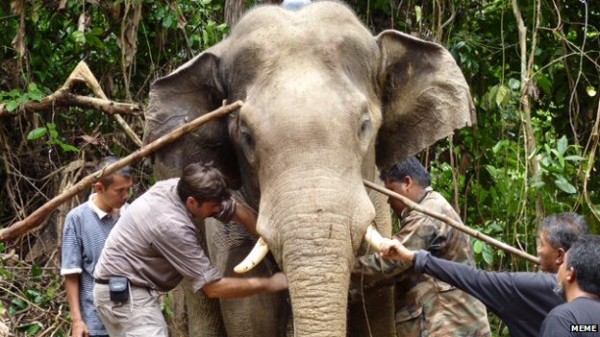
Elephants and humans are coming into contact with each other more often in Malaysia. The areas where elephants used to roam are being built upon or used for agriculture. Some favour relocating them to a national park – but is this the right thing to do?
There were only two things that scared our native guides: Tigers and elephants. When I asked them what was dangerous about the jungle they said – in all seriousness – everything.
But it was the faint possibility of unwittingly stumbling across a tiger that had them slightly on edge. Or an elephant. The latter scenario became more of a distinct possibility with every step we took.
We knew this because our radio detection receiver began to click ever more loudly, indicating that somewhere in the thick undergrowth lurked an elephant that had recently been captured near a village, tagged with GPS and radio beacons, and released safely here in the national park.
It seems to me there is an inherent contradiction in tracking elephants. You put a great deal of effort into finding them, but they say if you see one then you are too close.
They are known to charge humans. And you cannot outrun them. The advice is find the biggest tree you can and hide behind it.
We had spent three hours hacking through overgrown logging paths, pulling leeches from our bodies, swatting away mosquitoes and running from a swarm of wild bees. The plan was to find traces of our tagged elephant – more specifically its dung – and take samples for laboratory analysis.
A team from the University of Nottingham is investigating the impact of the relocation process. Certain hormones can indicate a rise in stress levels with potentially serious consequences for the animal’s health.
In the weeks before, eight elephants had been captured near a village in Perak state and released 100km (62 miles) away, but there is no consensus on whether translocation is actually effective over the long term.
The GPS collars have revealed that some make their way back home. Elephants it seems, really never forget.

Next day we drove down rutted cart tracks, past half-naked children playing in streams and into an Orang Asli village – the indigenous people of Malaysia. On the way we passed electric fences designed to keep out the elephants – but many of the barriers were broken or poorly maintained.
In a house made of bamboo and palm leaves we found Andak, the head man. Over tea he began to air a number of grievances the Orang Asli have against the government, but more specifically the problem of elephants.
His people used to be jungle nomads, living off the land with an uncanny way of finding their way through vegetation which can leave most people disorientated and lost. But the government is encouraging the Orang Asli to adopt a more settled lifestyle, cultivating the land, with the hope of tackling poverty.
Each family was given 400 rubber plant saplings worth around five ringgits (£1; $1.60) each.
But then came the elephants, eating crops, destroying a few flimsy buildings and, in extremely rare cases, attacking villagers. In the past they’ve even attacked the villagers. Once a plant is lost, Andak says the government will not replace it, so the villagers here have stopped cultivating new ones.
Andak admits the elephants were here first – but the problem is getting worse and his livelihood is at risk. “They used to come in ones and twos,” he tells me through an interpreter, “and they weren’t much of a problem. Now they come in herds of between ten and 12 and they eat anything they can find.”
The villagers used to patrol the fields at night but now they are too scared. What they need, he says, is some sort of buffer zone between the forest and the village.

Conflict between humans and elephants is not new, but the pace of agricultural change and development in Malaysia means the number of clashes is increasing. There are more plantations and logging activity is encroaching on elephant habitat.
On our way back from the village we stopped on a hillside and looked down into a valley where hundreds of tree trunks were awaiting collection. Beside me, clearly outlined in the soft mud, was the imprint of an elephant’s foot.
One regional wildlife official told me that translocation was the best solution for now, but then suggested that they could eventually create – in his words – a kind of Jurassic Park with huge fences to contain the elephants.
Barriers, translocation, compensation or just learning to live with elephants – no-one believes there is a simple solution. But there is an unspoken fear that unless the situation improves things could take a sinister turn.
Earlier this year in Malaysia’s Sabah state, 10 pygmy elephants were found poisoned. That has not happened in Perak – yet.
The elephants may indeed have been here first, but my strong impression from talking to farmers here is that patience is wearing thin.
Elephants in Malaysia

“A hundred years ago wild elephants on the Malay Peninsula could be counted in their thousands – now, due to the loss of habitat, there are less than 1,500.
“Hunted for their tusks and stripped of their natural habitat the Asian elephant is listed as endangered by the International Union for Conservation of Nature.
“Agriculture, roads, building development and widespread persecution as a result of human-elephant conflict is leading to this rapid decline and fragmentation of their population.
The girl who talks to elephants
In June, panic gripped the industrial city of Rourkela one night when a herd of wild elephants entered residential areas from dense forests nearby
Fourteen-year-old Nirmala Toppo acted as a real-life “pied-piper” when she managed to drive the herd back to the forest, much to the relief of the residents



Leave a reply